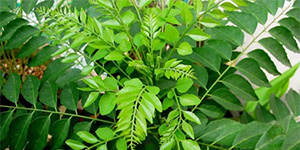AgTechNews.com
Crop Cultivation Guidence
SPICES & CONDIMENTS : Curry Leaf Cultivation
IntroductionCurry leaf plays an important role as a condiment in the culinary preparation of South Indian dishes. It is cultivated in field scale in Coimbatore, Periyar, Madurai, Salem and Trichy districts of Tamil Nadu and in Dharward, Belgaum and Uttara Kannada of Karnataka State. The botanical name of the curry leaf is Murrya koenigii Spreng. It belongs to the family Rutaceae. |
 |
Climate and Soil
It does not require a specific climate and can come up in dry climate too. In places where minimum temperature goes below 130C, the growth of shoot will be slightly affected. Though it can be cultivated in most of the soil types, it comes up well in light textured red soils.
Varieties
Farmer prefers local varieties, which have pink midrib. University of Agricultural Science, Dharwad has recently released two cultivars viz DWD – 1 and DWD –2 which have an oil content of 5.22 and 4.09% respectively. Both the varieties are having strong aroma.
Preparation of field and planting
Mainfield should be
ploughed repeatedly. Normally, a spacing of 90 to 120cm is followed on either side. One
month before planting, pits of 30 x 30 x 30cm dimensions are dug out and are filled with
top soil mixed with well decomposed farm yard manure at the time of planting. Healthy
seedlings are planted in the centre of the pits. Then long furrows are formed connecting
all the pits to facilitate easy irrigation.
The seedlings are
irrigated once in five to seven days upto three years and once in 15 days afterwards. The
field should be kept free of weeds. Normally curry leaf plants are not fertilized with
inorganic source by the farmers. However, for a better growth and yield, each plant may be
fertilized with 20kg of Farmyard manure besides 150g nitrogen, 25g phosphorus, and 50g of
potash per year.
Harvesting and yield
At the end of first year, the crop comes to first harvest. The expected yield from one hectare is given below:
| Age of plantation | Yield of leaves(kg/ha) |
|---|---|
| First year | 400 |
| Second & third year | 2000 to 2200 |
| Fourth year | 2500 |
| Fifth year onwards | 3500 to 5000 |
The plantation can be kept for 20 to 25 years depending upon the management practices followed.
Plant protection
Aphids attack the plant when the plants are in vegetative stage and spraying of dimethoate at the rate of 2ml/litre of water is recommended. Leaves from such sprayed plants should not be harvested for 10 days lest residual toxicity of the pesticide. Leaf spots sometimes occur and spraying carbendazim at the rate of one gram per litre is recommended.




